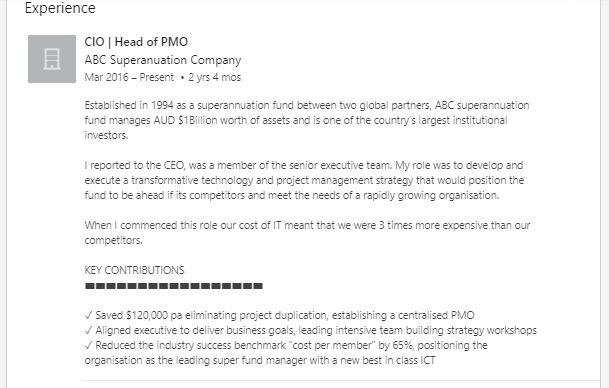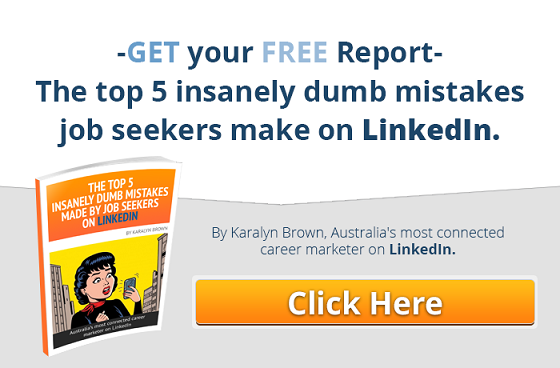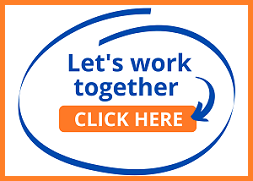
Photo by Bryce Koch on Unsplash
Have you ever wondered why some people get headhunted from LinkedIn and you do not?
If this is you, I suggest you read on.
From the many years I have spent helping clients construct their LinkedIn profiles I know how much people want the pain taken away from their job search.
They want their LinkedIn profile to attract opportunities for them. However they do not know what to actually put in their profiles so they simply leave big chunks of their LinkedIn profile blank.
They also let the reader second guess what they’ve done by only listing their job titles.
There’s a big problem with this.
The first thing to remember is that if people want to hire you or refer you to jobs, they need to understand you.
But it’s actually more than just reading what you have done.
Beyond simply understanding you, they need to trust you and understand how you could add value to their organisation.
This is what you see many people do in their experience section on LinkedIn.

While this provides a brief oversight of this CIO’s responsibilities – there is no context. I have no idea what the company does or an understanding of how the CIO added value to the company.
I need to make a lot of assumptions about her experience.
I see this type of detail time and time again on LinkedIn, and while I can understand that people have a reluctance to put it all out there, if you’re looking for a job you need to get the right message up.
So I have written this post to show you the proven method I use with my clients to unpack all the ways they may be able to add value and how I set these statements up in a way that helps someone scanning your profile, actually read these.
How to showcase your value in your experience section on LinkedIn
To determine what is relevant to showcase you need to start with understanding what your intention is with LinkedIn and who you want to attract to your profile. That can help guide you with the level of detail and the nature of that detail to include, and how you may prioritise this information.
For example, let’s say you are an Operations Manager and you have had project management accountabilities in your role. And let’s say you’re seeking to transition to that type of role for your next career move.
I would suggest that instead of focusing so much on your operations management responsibilities, that you prioritise the projects you have managed as your contributions or achievements.
There is no law on LinkedIn or on your resume either that states you need to include every small detail of your career. So keep the idea of audience relevance in mind when you put fingers to keyboard.
As I said before, to lift your profile above the thousands of other profiles out there, you need to not just list the responsibilities you have but you need to show how you have made a contribution with these.
Now that LinkedIn does not display the summary section in full (yes LinkedIn I’ll stop moaning about this shortly), I focus on showcasing someone’s contributions in the experience section. I do this because LinkedIn now displays the first 5 roles in full, before people need to click down to read more.
And as many people struggle with what to write around their achievements, I will show you the step by step method I use to help my clients uncover all the ways they may have added value, without even fully realising at the time.

Photo by Riccardo Annandale on Unsplash
So here we go….
Think about something that you’re proud of contributing, or achieving then answer these questions below. They are based on the STAR approach – similar to questions recruiters ask in interview.
For each achievement write down your answers to these questions:
- What was the problem you needed to solve, and why was this a problem?
- What steps did you take in resolving that problem?
- What was the result you delivered, and the value that solution added to the business?
Let’s go through a worked example for a CIO and PMO Manager working for a global super fund and I’ll show you how I distill this information down to a value statement for LinkedIn:
- What was the problem you needed to solve and why was this a problem?
“The Superannuation Fund Managers had experienced rapid organic growth over the past 20 years. Teams had been built in silos to respond to the growth of a particular product. So there was a lot of duplication of projects that could have been housed under a program management office with resources efficiently allocated to the business.
My problem to solve was to identify which projects had the biggest business benefit, which were duplicated, and which could be eliminated then re-establish the new program management office (PMO) to deliver these in the most efficient way, with clear lines of reporting back to the executive.”
- What steps did you take to resolve that problem?
“I firstly established a fact finding mission, consulting closely with the executive team to ensure I understood strategic priorities and the drivers they had to establishing their projects.
Then I organised with the head of L&D to develop a series of intensive workshops where we mapped out the overall vision and the key projects that the group ran as a whole. This helped the team identify where their activities contributed to the overall goal and where there were duplication in work. From there project priorities were established which became the first critical objectives of the PMO.
Within the PMO we recruited two Project Managers whose goal was to train the SMEs business in best practice project management methodologies, and manage the key projects within the PMO.”
- What was the result you delivered and the value that solution added to the business?
28 projects were streamlined into 7 key projects covering pillars of the business. The overall value was that we eliminated duplication which saved $120,000 pa in resource overlaps.
Here’s the formula I use to create a compelling achievement statement on LinkedIn
So the formula to create a contribution/achievement statement on LinkedIn is:
Achievement statement = The value you delivered with the problem you solved or solution you introduced.
In this scenario the explicitly expressed value the CIO delivered was:
Saving $120,000 pa eliminating project duplication.
The solution she delivered was:
establishing a centralised PMO.
Putting this together this becomes:
- Saved $120,000 pa eliminating project duplication, establishing a centralised PMO
Another measure of the value she delivered she did not explicitly express in her answers.
However you can see from her answers that in essence her work brought the management team together to think as one team. She helped the management team understand how they delivered value to the business, how their colleagues delivered value to the business and the business priorities of each management team member.
So applying my formula again the achievement/value statement becomes:
- Aligned the executive teams to deliver business goals, leading intensive team building strategy workshops
And this is what this looks like on LinkedIn:

As I mentioned before the value of using the STAR approach in developing an achievement/value statement is that it helps my clients tease out ALL the value they delivered in a particular scenario.
To make sense of this information I describe what the company does and what she does. Then I write about the key challenge the CIO faced. This gives context to the contribution she made.
The value of working with a professional like myself is I look at the information my clients provide and test and challenge the assumptions my clients make about their contribution – and if something they did generated a positive result, and it helps support my client’s argument to hire them for a particular role, it goes in.
Nine times out of ten I find my clients undersell themselves. They’ve usually achieved far more than they first think. So this type of process can be a big confidence booster.
[FREE REPORT] The Top 5 Insanely Dumb Mistakes Job Seekers Make on LinkedIn (And How to Fix Them)
Learn how to use your LinkedIn profile to attract attention from employers and headhunters.
Click here to get the report and top tips from me (Karalyn Brown) Australia’s most connected career professional on LinkedIn.

 Follow
Follow

{ 0 comments… add one now }